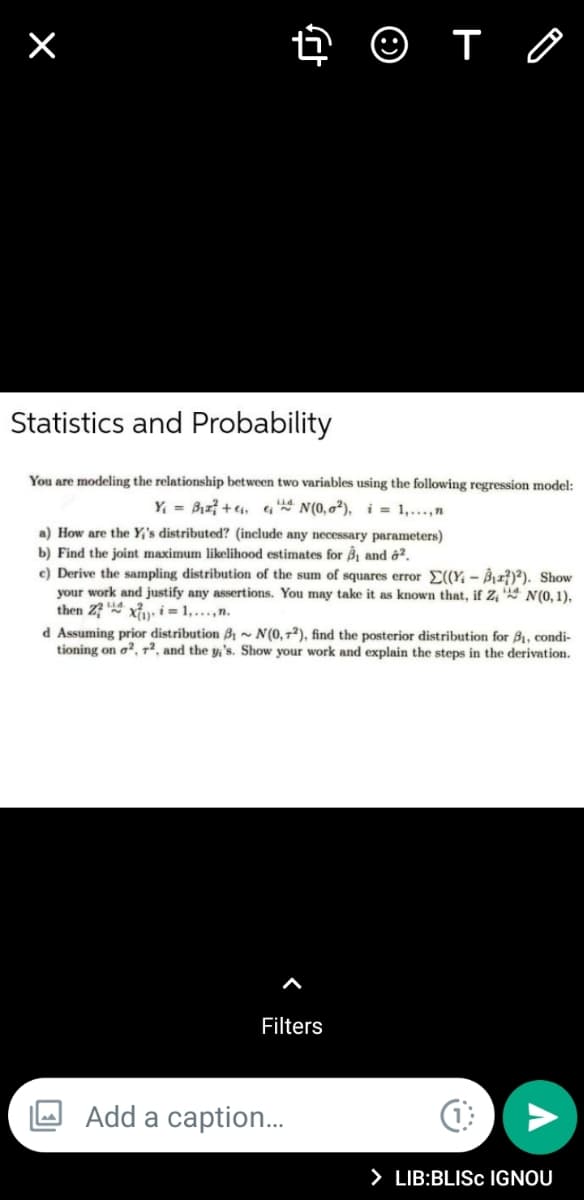You are modeling the relationship between two variables using the following regression model: Y, = Bız? + . N(0,02), i = 1,.,n a) How are the Y,'s distributed? (include any necessary parameters) b) Find the joint maximum likelihood estimates for B and ô². e) Derive the sampling distribution of the sum of squares error E((Y-A)?). Show your work and justify any assertions. You may take it as known that, if Z, N(0, 1), then Z? xy i = 1,...,n. d Assuming prior distribution B~ N(0,7²), find the posterior distribution for B1, condi- tioning on a, r, and the y,'s. Show your work and explain the steps in the derivation.
You are modeling the relationship between two variables using the following regression model: Y, = Bız? + . N(0,02), i = 1,.,n a) How are the Y,'s distributed? (include any necessary parameters) b) Find the joint maximum likelihood estimates for B and ô². e) Derive the sampling distribution of the sum of squares error E((Y-A)?). Show your work and justify any assertions. You may take it as known that, if Z, N(0, 1), then Z? xy i = 1,...,n. d Assuming prior distribution B~ N(0,7²), find the posterior distribution for B1, condi- tioning on a, r, and the y,'s. Show your work and explain the steps in the derivation.
Linear Algebra: A Modern Introduction
4th Edition
ISBN:9781285463247
Author:David Poole
Publisher:David Poole
Chapter4: Eigenvalues And Eigenvectors
Section4.6: Applications And The Perron-frobenius Theorem
Problem 25EQ
Related questions
Question
100%

Transcribed Image Text:Statistics and Probability
You are modeling the relationship between two variables using the following regression model:
Y, = Biz? + ei, q* N(0,0²), i = 1,...,n
a) How are the Y;'s distributed? (include any necessary parameters)
b) Find the joint maximum likelihood estimates for ßj and ô².
c) Derive the sampling distribution of the sum of squares error E(Y, – Bì±²)²). Show
your work and justify any assertions. You may take it as known that, if Z N(0, 1),
then Z? xu i = 1, ...,n.
d Assuming prior distribution B1 ~ N(0,72), find the posterior distribution for B1, condi-
tioning on o?, r², and the y,'s. Show your work and explain the steps in the derivation.
Filters
Add a caption..
> LIB:BLISC IGNOU
Expert Solution
This question has been solved!
Explore an expertly crafted, step-by-step solution for a thorough understanding of key concepts.
Step by step
Solved in 4 steps

Recommended textbooks for you

Linear Algebra: A Modern Introduction
Algebra
ISBN:
9781285463247
Author:
David Poole
Publisher:
Cengage Learning

Algebra & Trigonometry with Analytic Geometry
Algebra
ISBN:
9781133382119
Author:
Swokowski
Publisher:
Cengage

Linear Algebra: A Modern Introduction
Algebra
ISBN:
9781285463247
Author:
David Poole
Publisher:
Cengage Learning

Algebra & Trigonometry with Analytic Geometry
Algebra
ISBN:
9781133382119
Author:
Swokowski
Publisher:
Cengage